According provided by lens Nikon DX AF-S Micro Nikkor 85mm 1: 3.5G ED VR SWM IF Micro1: 1 many thanks to Vyacheslav.
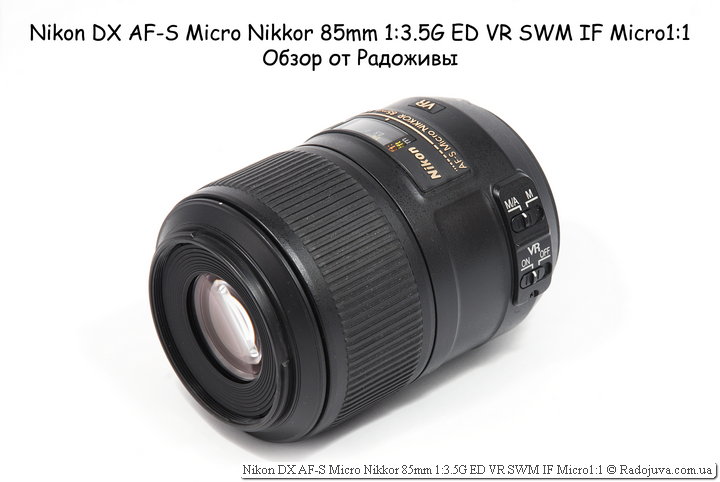
Nikon DX AF-S Micro Nikkor 85mm 1: 3.5G ED VR SWM IF Micro1: 1 review
Nikon DX AF-S Micro Nikkor 85mm 1: 3.5G ED VR SWM IF Micro1: 1 has a very long name, so in this review I will refer to it as 'Nikon Micro 85 / 3.5 VR'. The lens is one of two macro lenses specially designed for use on crop cameras Nikon DX... Another macro lens is Nikon DX AF-S Micro Nikkor 40mm 1: 2.8G.
The lens has a small front lens and on the camera looks like lens changer - as if it was put on the camera backwards, but if you put on a hood on the Nikon Micro 85 / 3.5 VR, it turns into a regular fix.
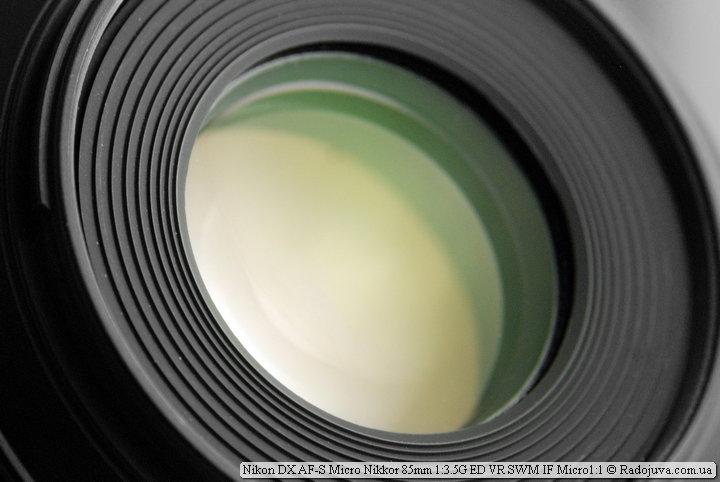
Nikon DX AF-S Micro Nikkor 85mm 1: 3.5G ED VR SWM IF Micro1: 1 Front Lens with SIC Coating
Nikon Micro 85 / 3.5 VR has a built-in focus motor and will work on all Nikon SLR cameras, even the most 'simple' ones. Unlike a huge number of full-format macro lenses, Nikon Micro 85 / 3.5 VR has internal focus. When focusing, neither the front nor the rear lens rotates, and the trunk does not lengthen. At first, I was very upset by the lack of a focusing distance limiter, which is present in most macro lenses, but the speed of the automatic focusing system was quite enough to more or less comfortably shoot both ordinary scenes and macro. The focusing speed itself is average, only slightly less than the full-size Nikon 105mm f / 2.8 VR G Micro-NIKKOR in the 'Full' mode (if you compare the focusing time from infinity to MDF and vice versa).
Also on the lens barrel you can find the 'M / A - M' focus switch. In the 'M / A' mode, automatic focusing with manual priority works, how to use it is described in the section on 'M / A mode'. The Nikon Micro 85 / 3.5 VR has a large rubberized focusing ring that rotates approximately 120 degrees in the active position. I didn't have enough ring travel for easy focusing, especially at long distances. On the lens focusing distance scale, infinity begins immediately after 1 meter. The distance scale is aligned with the macro scale.
Main technical specifications of the Nikon DX AF-S Micro Nikkor 85mm 1: 3.5G ED VR SWM IF Micro 1: 1
| Review Instance Name | Nikon DX AF-S Micro Nikkor 85mm 1: 3.5G ED VR SWM IF Micro1: 1 2034882 |
| Basic properties |
|
| Front Filter Diameter | 52 mm, plastic thread for filters |
| Focal length | 85mm Equivalent Focal Length (EGF) for cameras Nikon DX is 127.5 mm. |
| Zoom ratio | 1 X (this is a fixed lens, it does not have a zoom) |
| Designed by | for Nikon DX digital cameras (with APS-C sensor) |
| Number of aperture blades | 9 rounded pieces |
| Tags | mount bayonet mount and hood mounts, focus distance scale in meters and feet, magnification scale from 1:10 to 1: 1 |
| Diaphragm | F / 3.5 to F / 22, without aperture ring. |
| MDF | 0.286 m, maximum magnification ratio 1: 1 |
| The weight | 355 g |
| Optical design | 14 elements in 10 groups. The scheme includes 1 low dispersion element (shown in yellow on the optical scheme). The presence of such elements is indicated on the body by the abbreviation 'ED'.
Scheme is increased by click |
| Lens hood | Nikon HB-37, bayonet type, plastic, comes standard. Lenses use the same lens hood: |
| Manufacturer country | MADE IN CHINA (Made in China) |
| Period | From October 2009 to the present |
| Instruction | View -> |
| 3d view | View -> |
| Price |
Nikon Micro 85 / 3.5 VR has a wonderful built-in image stabilizer... and the 'VR ON - OFF' switch. When the stabilization mechanism is turned on and off, the lens produces a sound like a clicking sound. The stabilizer works very well. True, for macro photography, very tight apertures are usually required, and no stabilizer will help. I don't know why, but no one mentions the fact that the stabilizer in the Nikon Micro 85 / 3.5 VR eliminates the 'jerking' of the image in the optical viewfinder. Due to the specifics of its work, Nikon Micro 85 / 3.5 VR suffers a lot. 'lack of Hollywood focus', which is why the picture in JVI when working in macro mode, it twitches very much. We can say that in macro mode, the 'wiggle' effect is enhanced.
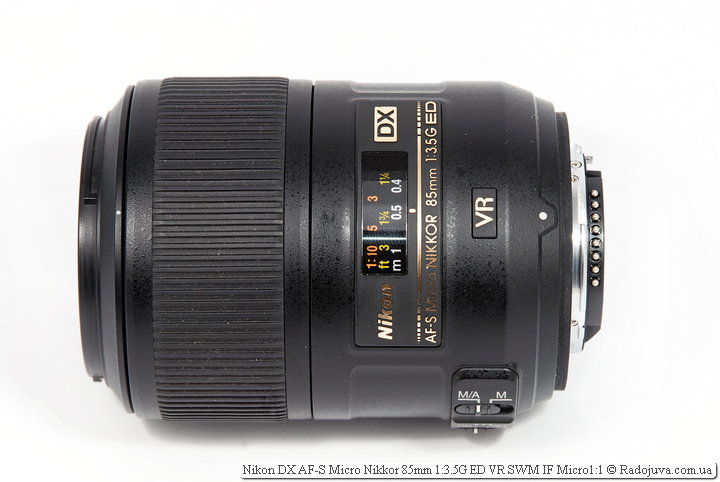
Nikon DX AF-S Micro Nikkor 85mm 1: 3.5G ED VR SWM IF Micro1: 1. Side view.
For a fixed lens, the Nikon Micro 85 / 3.5 VR has a weak aperture. As well as other macro lenses, for example Nikon AF Micro Nikkor 105mm 1: 2.8DThe Nikon Micro 85 / 3.5 VR changes the minimum F-number when focusing. When the lens is focused on infinity, you can actually use the F / 3.5 value, but as soon as the lens begins to focus towards the minimum focusing distance, the F value rises, and on the MDF (about 29 cm) it becomes equal to F / 5.3.
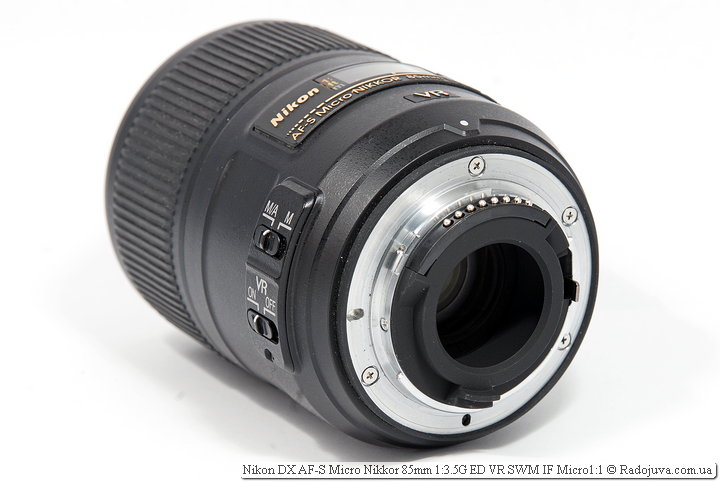
Nikon DX AF-S Micro Nikkor 85mm 1: 3.5G ED VR SWM IF Micro1: 1 rear view. Metal lens mount
The lens comes with a sturdy plastic lens hood HB-37. The lens hood snaps into place using special slots. In macro photography with the built-in flash, the lens hood casts a shadow in the photo. The hood can be worn backwards and always carried with you, although in this position it completely blocks access to the lens focus ring.
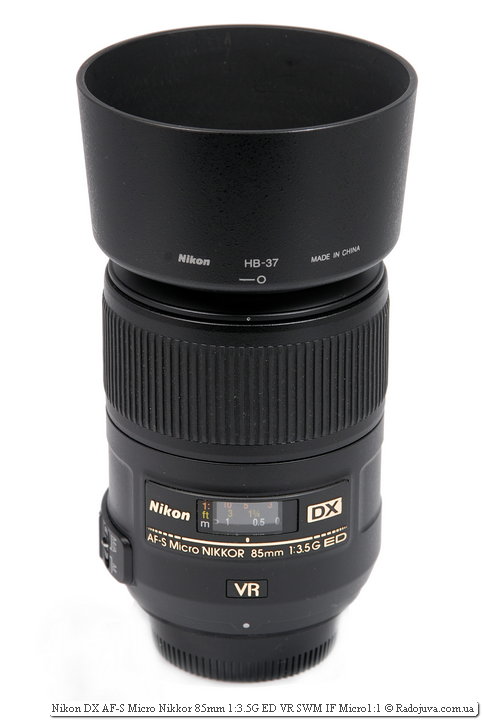
Nikon DX AF-S Micro Nikkor 85mm 1: 3.5G ED VR SWM IF Micro 1: 1 with a fitted hood
Nikon Micro 85 / 3.5 VR manufactured in China since October 2009... The assembly is not bad, I did not find any complaints about its quality. Everything is in its place - a lot of plastic, but with a metal mount, which is quite justified for the price tag of the lens.
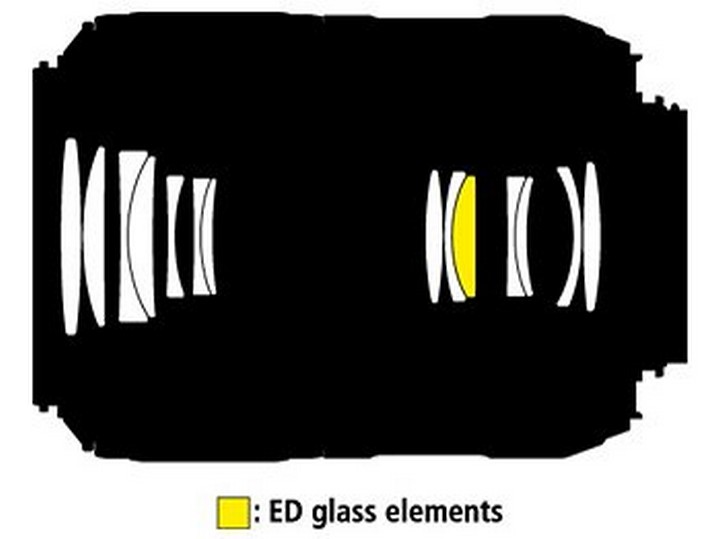
Optical design of the Nikon 85mm f / 3.5G ED VR AF-S DX Micro-Nikkor. Yellow indicates an element made of ED glass.
Nikon's official website shows pretty pretty MTF chart. In practice, I did not notice any serious flaws in the image quality.
The parameters shown in the photo gallery:
Everything is filmed on Nikon D80 and Nikon DX AF-S Micro Nikkor 85mm 1: 3.5G ED VR SWM IF Micro1: 1 using protective filter Hoya HMC UV (c) 52mm. On-camera JPEG L Fine. Noise reduction at slow shutter speeds and noise reduction at high ISO were turned off. Everything was shot in N (Neutral) Picture Control. Was used white balance: 'Flash' and 'Auto'. The size of the photos was reduced to 3 MP.
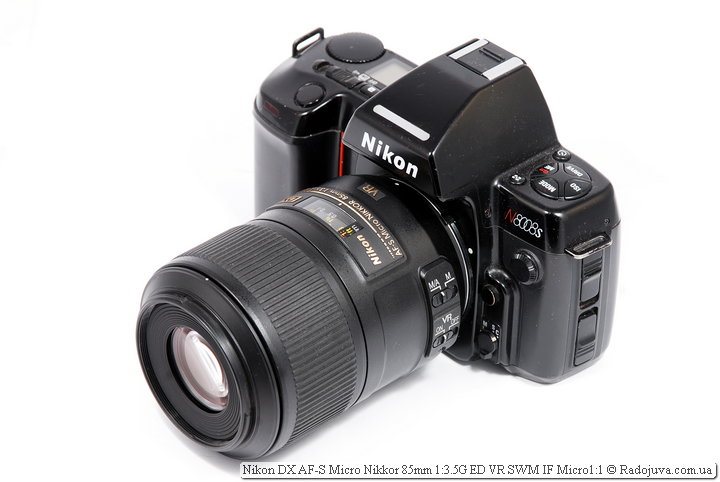
Nikon DX AF-S Micro Nikkor 85mm 1: 3.5G ED VR SWM IF Micro1: 1 on ZK
Prices for the Nikon DX AF-S Micro Nikkor 85mm 1: 3.5G ED VR SWM IF Micro1: 1 lens in popular stores can look at this link, or in the price block below:
All autofocus MICRO / MC NIKKOR lenses
Z-mount FX:
F-mount FX:
- Nikon AF Micro Nikkor 50 mm 1:2.8 R-UW
- Nikon AF Micro Nikkor 55 mm 1:2.8
- Nikon AF Micro Nikkor 60 mm 1:2.8
- Nikon AF Micro Nikkor 60 mm 1: 2.8D
- Nikon N AF-S Micro Nikkor 60 mm 1: 2.8G SWM ED IF Aspherical Nano Crystal Coat (Japan or Thailand)
- Nikon AF Micro Nikkor 105 mm 1:2.8
- Nikon AF Micro Nikkor 105 mm 1: 2.8D
- Nikon N AF-S Micro Nikkor 105 mm 1: 2.8G ED VR SWM IF Micro 1: 1 Nano Crystal Coat (Japan or China)
- Nikon ED AF Micro Nikkor 200 mm 1: 4D
- Nikon AF Micro Nikkor 70-180 mm 1: 4.5-5.6D ED
F-mount DX:
- Nikon DX AF-S Micro Nikkor 40 mm 1: 2.8G SWM
- Nikon DX AF-S Micro Nikkor 85 mm 1: 3.5G ED VR SWM IF Micro 1: 1
An accurate list of all Nikon DX Nikkor lenses
- 10.5 mm/ 2.8G AF Fisheye [gold ring]
- 35 mm/1.8G AF-S
- 40 mm/2.8G AF-S Microphone
- 85 mm/3.5G AF-S VR Microphone
- 10-20 mm/4.5-5.6G AF-P VR
- 10-24 mm/3.5-4.5G AF-S
- 12-24 mm/4G AF-S [gold ring]
- 16-80 mm/ 2.8-4IN AF S VR [gold ring]
- 16-85 mm/3.5-5.6G AF-S VR
- 17-55 mm/2.8G AF-S [gold ring]
- 18-55 mm/3.5-5.6G AF-S [black / silver]
- 18-55 mm/3.5-5.6GII AF-S [black / silver]
- 18-55 mm/3.5-5.6G AF-S VR
- 18-55 mm/3.5-5.6GII AF-S VR
- 18-55 mm/3.5-5.6G AF-P
- 18-55 mm/3.5-5.6G AF-P VR
- 18-70 mm/3.5-4.5G AF-S
- 18-105 mm/3.5-5.6G AF-S VR [Thailand / China]
- 18-135 mm/3.5-5.6G AF-S
- 18-140 mm/3.5-5.6G AF-S VR [Thailand / China]
- 18-200 mm/3.5-5.6G AF-S VR [Japan / China]
- 18-200 mm/3.5-5.6GII AF-S VR
- 18-300 mm/3.5-5.6G VR
- 18-300 mm/3.5-6.3G VR
- 55-200 mm/4-5.6G AF-S [black / silver, Japan / China]
- 55-200 mm/4-5.6G AF-S VR
- 55-200 mm/4-5.6GII ED VR
- 55-300 mm/4.5-5.6G AF-S VR
- 70-300 mm/4.5-6.3G AF-P
- 70-300 mm/4.5-6.3G AF-P VR
Comments on this post do not require registration. Anyone can leave a comment. Many different photographic equipment can be found on AliExpress.
Results
Surprisingly, the not very expensive Nikon Micro 85 / 3.5 VR turned out to be a solid lens. It has everything you need for comfortable operation - internal focusing, image stabilization, light weight, metal lens mount and true macro mode with 1: 1 magnification. It's also a sin to complain about the image quality.
Please note that macro photography is a rather tricky area. Even with a dedicated lens like this, it is sometimes difficult to get a good shot. A lot of users often catch the idea of macro photography, but as it comes down to it, there are many frustrations when faced with a number of difficulties. First of all, difficulties are associated with a small depth of field and a constant lack of light when shooting with a closed aperture. So think carefully - do you need a special macro lens? To do this, I advise you to familiarize yourself with the features of macro photography using macro rings for any of your lenses, and then think about the need to purchase a specialized macro lens.
Material prepared Arkady Shapoval. Training/Consultations | Youtube | Facebook | Instagram | Twitter | Telegram

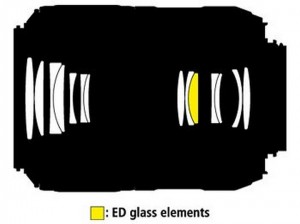
















Not enough aperture. Even for the price. Although this lens is the only salvation for amateurs with non-motorized carcasses, as the more “advanced” ones will buy a regular Nikkor AF 85mm non-motorized fix with a large hole. The presence of a stub is a wonderful help, which speaks in favor of this lens, but it is slightly leveled before a non-autofocus fix due to the low aperture ratio. Say what you like, and the bokeh of the “usual” 85s due to the smaller depth of field will be more interesting for portraits.
You write about absolutely different classes and types of lenses.
If you take it specifically for macro photography, then perhaps there is no alternative to an amateur crop. But an amateur who is seriously interested in macro photography is unlikely to bite on such a glass. It would be much more logical to take 105mm Af mikro-nikkor. The price of a new one is a couple of hundred greens higher, but it is not necessary to take a new one. Used can be found for $ 400, and the picture from it is much more interesting (subjective opinion) and aperture higher, and FF again. Such a lens will not interest professionals at all, and amateurs who are able to spend about $ 500 on a fix, and even such a narrow focus, will probably be picked up with a gulkin nose.
That's right, so lovers take 40 / 2,8 more willingly.
Arkady, tell me, please, is this lens suitable for shooting a subject - small toys (14-20 cm) and shooting from a hand - when I hold a part on one hand and remove it with the other? I plan to shoot workshops on knitting (small parts) and finished toys in the interior.
I can’t decide to buy it, it’s not in our city, so there’s no way to even see it, only on order.
Suitable, but a tripod is still desirable)
85mm is suitable, but it is better to take 60mm 2.8G with it will be easier, 85mm is already long for crop. For such images, a 40mm F / 2.8 Micro is also suitable, it is inexpensive. To remove an object from hand is not always easy. You should have some kind of regular lens, such as 18-55 or 18-105 / 18-140, try shooting and it also has a good increase and maybe instead of a new lens, you better buy an external flash or a tripod.
This format, for example
And such a plan
1. not everyone will take a 105af for a non-motorized carcass, and a motorized 105af-s is more expensive.
2. no one bothers to find the same 85 / 3,5 from hand, and not for 500 bucks
3. it all depends on the tasks, but the objective and the truth of narrow application, for a “beginner but wanting a macro”, 60 / 2,8 may be more universal.
I agree. 85 costs $ 500, 105 $ 800 - the difference is significant for an amateur.
60-ka costs as much as 85 and it seems to be good for everyone, but the minimum focusing distance is less (and there is no stub). Those. the chance that the bee will fly away when you try to get closer. So for myself (an amateur), I am already inclined to 85-ke for the New Year :)
Arkadmy, have you tried to shoot portraits for them? It seems to be the focal point, but at 3.5 just the whole face will fit into the depth of field - maybe you don't need aperture more?
On 3.5, the portrait will not work, except that the growth, and so the aperture will drop to F / 4.0. Of course, they can take portraits :)
Indeed, 60mm will obviously be more interesting. He is also a FF. An amateur photographer, for whom a hobby means a lot, will not take pictures all his life for crop, so I don’t see any point in putting up cropped optics for such tasks.
“The amateur photographer for whom hobby means a lot will not shoot cropping all his life.” Oh really? For more than 10 years I have been shooting with crops (Nikon D50, D200, D7000, D500) and I'm not going to switch to FF yet.
Well, in vain. Read the opinion of Arkady about FF after crop.
For work, FF is definitely needed, for an amateur, just straight hands will do, I myself have several crops, including the “not interesting” d60 :)
for an amateur and a smartphone is suitable, it often removes better than old crop.
I, as an amateur with crop, constantly think about some loss of detail in view of the greater distance to the object; that the full potential of the glass is not used.
This glass is made for crop, so that all potential is used.
Ideal for a beginner mackerel =) the minimum focusing distance is as much as 28 cm, the insects cannot be scared away. The stabilizer generally makes it universal, allows you to shoot everything handheld - and for macro, and for portraits and for everything else.
I recommend reading before buying, useful https://buynbest.ru/luchshij-makroobektiv-nikon/
yeah, 500 bucks is a little expensive for a dx lens, Arkady thank you for your work.
The lens is good for subject and macro photography on DX cameras. It has good sharpness over the entire field and there are practically no chromatic aberrations. I have had this lens for about two years now.
Do_Oraemon, unless all amateurs for whom hobby means a lot should switch to FF? Firstly, the price of the question is completely different ... Secondly, we talked about macro, and it is better (easier) to shoot macro on a crop, isn't it?
No one owes anything to anyone. But stocking up with a set of optics under the crop is stupid. Why not take the same mikro-nikkor 60mm for an amateur camera? The price is almost the same. But at the same time there will be a small reserve for the future, do not you think so? I know lovers who had to sell cropped glass in connection with the transition to a full frame. Naturally, at the same time they lost part of the cost and were forced to pay almost twice for glasses of the same type. And even if you do not take this into account, all the same, full-frame lenses are more competitive, because they are sharper on crop than DX glass, because the camera shoots the central part of the frame, which is the sharpest in any glass. And the aperture plays an important role. 2,8 vs 3,5. For me, for example, this plays a role. And at almost the same cost, I would naturally give preference to a faster aperture, full-frame lens. Stabilizer? Maybe. But this is the only plus of this lens to rivals.
Not the only one. Focusing distance at 1: 1 magnification at 60-ke 5 cm, and at 85-ke 11.5 cm. The difference is significant. For a subject, of course, no difference, but for insects - no.
Not convinced. Because in that case, I would have interrupted somehow for another six months and would have taken 105mm AF-S, spit on its cost (but in fact, I have a camera with a screwdriver and I would have taken the non-motor version for the same price). Well, the picture from 85 doesn’t impress me, even though it’s crack. And to take glass because "cheaply, angrily and I want right now" I can’t. I understand that you have already looked after it for a purchase and your opinion cannot be changed, but I do not think that you yourself want to be disappointed after the purchase and sell it safely in a year. Well, you will not, in fact, remove only insects? Surely and portraiturer will want. You saved at one time by buying a camera without a screwdriver, and now you have only two options - either to buy low-quality optics for crop, or pay crazy money for full-frame motorized windows. And where did you save it? On quality? Big sacrifice.
I managed to get 85 completely new off. $ 370 guarantee! Probably worth the price? I will master :)
WELL SAID. I completely agree!
And I bought myself as soon as it appeared on sale. Ordered from America. Took for a subject. When buying such a lens, you definitely need to know what you want. Then he will delight. For those items that I rent I do not need the best. I really like portraits from him. For those who do not have enough light came up with a flash. Macro and subject matter require a thoughtful approach, and seriously using 2,8 for macro is very doubtful. The main thing is to understand why it is needed and then everything will work out. I highly recommend for a purchase.
And how can a portrait be used?
I am newbie. help me please.
such a situation, I can’t find / understand where the manual focus ring is, only the zoom
I have a whale, there when in manual mode you twist / adjust near the first lens ..
but there’s no such thing
only the big ring is spinning….
but really necessary
I will be very grateful for the answer
The lens does not have a zoom (zoom ratio is 1x), and the only large focus ring is responsible for focusing, and twist it.
thank you very much)
Thinking about purchasing a macro lens, help me choose for Nikon D90, which one is better to take Marko 40, 60 or 85. The main purpose for shooting individual details, can also try in portraits. Thank you
105 AF-S 2,8 g micro nikkor, for all occasions. Macro, subject, portrait, razor sharp as (diarrhea), stabilizer is beyond praise, autofocus in macro mode catches up even very nimble insects. Complete with autofocus macro rings it becomes almost a microscope. Two years of use and sheer pleasure.
Arkady, help me decide on the choice of a macro lens for dentistry. Camera d7000 with a whale fifty dollars. I would like not to poke the patient in the face with a lens, but only teeth should fall into the frame. I must say that the Nikon AF 105mm f / 2.8D Micro-Nikkor is expensive.
I would recommend 60 or even 40 mm makriki, besides 40 mm inexpensive ..
and for low-cost means - take an annular flash for example.
look to the side (read the reviews) of non-native optics, Sigma 105 / 2.8 dg macro (200-300 cu) or Cosina 100 mm f / 3.5 Macro aka Soligor 100 mm f / 3.5 MC Macro, it’s a few more names ( 100 cu), however, the construct is weak, but cheap and sharpness is not bad.
in the review 40 mm, the focusing distance to the front lens of the lens is 4 cm, if you move it by 10-15 cm, what will fit into the frame?
4 cm, this is a distance with a magnification of 1: 1, that is, two or three teeth will fit into the entire photo. If you take a step back, the whole head will fit in, and then, after all, you can frame it, that is, crop it as you need. 40mm is fine for you.
Soligor 100 mm f / 3.5 MC Macro lens. Photo from a distance of 30 cm from the front lens of the lens to the calculator, button size - 9 * 14mm, total width of buttons - 50 mm, height -33 mm, so it will be easier to imagine what will fit into the frame
When the whole head gets in, you have to cut it off and the quality drops. Out-of-focus photos are produced. I need only teeth to be in the frame from a distance of 10-15 cm, or is that not so?
I don’t know what kind of whale fifty dollars you’re talking about, but with 50 mm you can focus from a distance of 45-50 cm, of course you need to crop properly, besides 40 ka is much sharper and the detail will be higher. Well, 10-15 cm and even 20 will be just right for you.
Thanks to everyone for the advice, special thanks to Yuri, they helped a lot. Stopped at 85mm, try and make up your mind)
hello Arkady! The question is, but in the Nikon 28-105mm f / 3.5-4.5D AF Zoom-Nikkor, when you increase the focal length to 105 and shoot in macro, the aperture remains 4,5 or becomes less than stated
Remains 4.5, but, the real aperture of the lens falls at the same time (the camera just does not show the recalculation of the number F)
I saw in the store an inexpensive macro lens of vivitar for canon 100f3.5. Please tell the amateur what kind of "beast" is and can it be adapted to a cropped nikon through some kind of adapter? And the adapter should be with a chip, as I understand it, so that he sees and controls the lens? And are there any in nature?
“Inexpensive macro lens vivitar for canon 100f3.5. Please tell the lover what kind of “beast” it is and can it be adapted to a cropped nikon ”Chips that is, but:
Any lens that does not have a Nikon mount is very uncomfortable to use on a Nikon for macro.
This applies to other systems if you put a lens with a non-native mount on them.
Since the “native” aperture jumper disappears. You will have to focus either on a closed diaphragm in macro from 8-16 (it will be dark, it will be difficult to see) or turn the aperture - “open for aiming, close for shooting” which from the hand, and even in nature, greatly slows down the work and the insect may not wait.
How much is applicable as the only short telephoto? What is the speed of auto focus compared to 18-55 VR and 35 1.8 G DX? Is there distortion when shooting facial portraits? At what aperture values does diffraction become noticeable?
not really.
The 85 mm DX VR lens is unique (others do not seem to have such a combination): with its very low weight (much less even than 60.2.8), the very large distance from the front lens to the object (approx. 15 cm by 1: 1, which is almost three times as much than 40mm with a DX dropping out proboscis macro). Nothing is spinning or moving. With excellent image quality, especially in macro. It is not a problem (and by weight and um it is not so pitiful) it is almost always to take it with you to nature, unlike the weighty and excess full-frame 90-100 / 2.8 makriki. In addition, the front lens is small (which is safer) and the filters / nozzles for its thread 52mm (like 18-55 whales) are cheap. Conveniently integrates into hinged macro lighting systems.
As for portraits, 2.8 macrocompetitors at portrait ranges are not 2.8 at all, but darker.
At full frame, only the corners are obscured, which, as a rule, in macro photography is cut off anyway, is quite suitable.
I completely agree.
An ideal and unique option for a novice maker =) minimum focusing distance as much as 28 cm, insects cannot be scared away. The stabilizer generally makes it universal, allows you to shoot everything handheld - and for macro, and for portraits and for everything else.
I recommend reading before buying, useful https://buynbest.ru/luchshij-makroobektiv-nikon/
But do not tell me for a photo of jewelry fit?
Yes one hundred percent
"The focal length is 85mm, the Equivalent Focal Length (EFR) for Nikon DX cameras is 127.5mm."
So it is already 85mm, moreover, for Nikon DX cameras.
Bl ... be! Another!
You should apologize, sir.
If there is a reason ... Why not.
Focal is considered to be considered for FF, when moving the lens to crop (1,5; 2, etc.), the edges of the picture are cropped and it looks like 127,5mm on FF; 170mm, etc. Those. EGF for crop.
Focal length is a characteristic of the lens and does not change from use at different frame sizes. But EGF just decided to lead to a narrow format
Gentlemen, thank you for your clarifications, however, this is a case ...
Here Arkady says:
https://radojuva.com/2012/10/lens-mm/
“Attention: the focal length of a lens is a physical quantity of the lens itself, it does not change and does not depend on the type of camera on which the lens is used. But for cropped cameras and for cameras with different physical matrix sizes, the EGF parameter (effective focal length) was invented, it shows the real angle of view for 35mm film, which is obtained when using one or another lens on cameras with different matrix sizes. "
Once again: “the EGF parameter shows the real angle of view for 35mm film”, and 35mm film is for FX cameras (full frame = 35mm film).
Thus, the expression “Equivalent Focal Length (EGF) for Nikon DX cameras” is not applicable, but the following must be specified: “Equivalent Focal Length (Focal Length) for FX cameras”.
Here's more: https://radojuva.com/2011/03/obzor-nikkor-af-s-35mm-f1-8-dx/
“35mm, Nikon DX Equivalent Focal Length (EFR) is 52,5mm (Spoiler alert: I’ll go nuts about these nonsensical comments about focal lengths and their recalculation. Everything is exactly the same as described above. No options.)”
So what?
Look, Arkady ... You write about the EGF like this: "for cropped cameras and for cameras with different physical matrix sizes, we came up with the EGF parameter (effective focal length), it shows the real angle of view for 35mm film."
This is both good and right, since the format of a 35mm film (aka FX) along with full-frame lenses should be close to many, if not most. Thus, you explain that for owners of cropped cameras an EFR parameter is provided, which only gives an idea of the viewing angle on a 35mm film obtained with a lens corresponding to this format.
However, further in the reviews you write: “Focal length 85 mm, Equivalent Focal Length (EGF) for Nikon DX cameras is 127.5 mm.”
And it would be necessary: “Focal length 85 mm, Equivalent Focal Length (EGF) for Nikon FX cameras is 127.5 mm.”
It is stated about the need to transfer from DX to FX in the table at the very beginning of this article (and some others) - and it will turn out as it says in https://radojuva.com/2012/10/lens-mm/
Just so it will be, in my opinion, right.
Thanks for attention. Sincerely.
In fact, “85mm focal length, Nikon DX Equivalent Focal Length (EFR) is 127.5mm” is also correct. It is understood that the recalculation is carried out specifically for DX, and not, for example, for CX.
For example, it would be “Focal length 85mm, Equivalent Focal Length (EFR) for Nikon CX cameras is 229.5mm”.
In general, about FR and EFR - one of the most frequent questions that is asked and “protested” under any review. Everyone wants to come up with something new :)
When will you all learn something?
Learning ... learning ...
For this, such places are intended - for study and for development in general.
And not at all in order to show your “FE”.
My question is being actively discussed .. even Arkady got involved ... soon everything will become clear, and first of all to me, for which I will be grateful to the entire public who took part :)
There is one very simple rule:
We take the lens from the review: Nikon DX AF-S Micro Nikkor 85mm 1: 3.5G ED VR SWM IF Micro 1: 1, put it on any Nikon DX camera (for which it is designed with a special marking DX in its name). Following the rule, we look: we have a DX camera, so for it, in any case, with any lens, you need to recalculate EFR.
This leads to the next question - what will happen to the EGF for a full-frame camera? On a full-frame camera, this lens will have FR and EFR equal to 85 mm. At the same time, it will simply give the strongest vignette, because it is not designed to work with FX cameras.
Some Nikon DX lenses have a "headroom" of performance and can work on Nikon FX cameras without much vignette. For instance - https://radojuva.com/2012/09/living-with-nice-lens-v/ On a full frame, the indicated focal length will be “fair”; on a cropped camera, you will always need to look for an EGF.
Some lenses (mainly for compact cameras) have two focal values on the lens - EGF and FR (example)
If you, Stanislav, knew how many times only on this site there were statements and questions similar to yours and how many times Arkady (and not only) patiently explained rather obvious things, then the reaction to your question would seem very soft to you.
Those. You think 85mm on dx is exactly 85mm
I hope it will be readable:
No, fundamentally wrong.
What is CX - https://radojuva.com/2012/03/nikon-lenses/#cx-nikon
Not a bit convinced :)
I wish you success, kindness and care! :))
Thanks. Usually, this is how everyone moves off topic.
I do not move, but I see how you, not accepting weighty evidence, complain that you have not been convinced ... Your will.
I can repeat, but it seems that you already understood everything, but to admit that yes - there is a mistake and for good - simply to correct it - the spirit is not enough.
Arkady, that it’s not clear to you what exactly in my presentation seemed unconvincing to you? For my part, I’m ready to help you understand for sure.
Okay, I am always for correct information. Let us slowly and methodically as clearly and clearly as possible. In the next message, indicate your point of view or your vision or my inaccuracies. Everything that was described above does not have any special fundamental remarks, again, in my opinion. Also, the topic of EFR and FR was raised many times, therefore I am rather dry and boring about any attempt to discuss it.
Okay, Arkady - I'll try slowly and methodically. So, taken to choose from two reviews, in which inaccuracies were noticed:
A) In this article: “Focal length 85 mm, Equivalent Focal Length (EGF) for Nikon DX cameras is 127.5 mm.”
B) Article https://radojuva.com/2011/03/obzor-nikkor-af-s-35mm-f1-8-dx/ : “35 mm, Equivalent Focal Length (EGF) for Nikon DX cameras is 52,5 mm (Spoiler: I will soon get out of these meaningless comments about focal lengths and their recounting. Everything is exactly as described above. Without options.) "
What is the inaccuracy? In both cases, the phrase sounds: "... for Nikon DX cameras" - apparently it is wrong.
Why is it wrong? - Read: https://radojuva.com/2012/10/lens-mm/ : “Attention: the focal length of the lens is the physical value of the lens itself, it does not change and does not depend on the type of camera on which the lens is used. But for cropped cameras and for cameras with different physical matrix sizes, the EFR (effective focal length) parameter was invented, it shows the real viewing angle for a 35mm film, which is obtained when using one lens or another on cameras with different matrix sizes. ”
It must be understood that the EGF parameter for a 35mm film did not appear from scratch, but as a result of the fact that a 35mm film was distributed for a whole era and very widely, respectively, a whole layer of a wide variety of cameras was used by people.
Once again we read the words from the aforementioned article and note for ourselves the main thing: for the owner of the crop camera (with any lens mounted on it), we apply a conditional parameter called EFR, which shows the real (identical) viewing angle for 35 mm film (FX- format). EGF is given in mm of focal length.
Clearly note for ourselves again. The EGF parameter is given in mm for a 35mm film (FX format) with an identical viewing angle of the lens (of any format) on the crop camera (DX format).
Now, to fix this in practice, we will use three different lenses from different eras, for example: Vega-12B, Jupiter-9, Nikon DX 85mm:
What is it and what does it eat?
1) A “Vega-6B” lens (film or slides 12 * 6cm) with a 6 ° angle of field of view was installed on a medium-format (denoted “SF”) Kiev-47S camera. This is common knowledge. If you install the same lens on a camera with 35 mm film (FX format), then the angle will change - it will become smaller (for simplicity, I suggest taking the crop factor between SF and FX equal to 1,5), namely: 47 ° * 1,5, 31 = 1,5 °. Accordingly, for a DX-format camera, this lens will be used with an even smaller angle (the crop factor between FX and DX is also taken equal to 31), namely: 1,5 ° * 21 = XNUMX °.
2) We complicate the task: we take "Jupiter-9" - it is already from 35mm film and has a field of view of 29 °. You can also put it on a crop camera and, if you try, you can stick it on an SF camera. And what can come of it? On the crop, the angle will become smaller: 29 ° * 1,5 = 19 °. And as for its installation on an SF-format camera, it will not do without a terrible black vignette, since initially this lens is not able to cover such a large field of the frame. However, in order to understand the behavior on the SF camera, the EGF parameter described above is introduced. This parameter shows what kind of SF lens is needed (with what "millimeter" focal length) in order to see the same field of view as an FX-format lens on 35mm film with the indicated "85mm" on board.
3) The notorious “Nikon DX 85mm” lens, strictly speaking, is designed exclusively for crop cameras and its installation on the FX format will approximately lead to what the installation of the FX format lens on the SF camera leads to. It's clear. But those who live in the FX-format will immediately realize what the given lens is on crop (on a DX-format camera). According to the passport, the angle of the field of view of this lens on the crop is 18,5 °, respectively, for the FX-format EGF will be 85mm * 1,5 = 127,5mm. And if you go even further - then on the SF camera for a given field of view angle (18,5 °) the EGF will be: 127,5mm * 1,5 = 191mm.
Finished with practice. Conclusions.
For the Nikon DX 85mm, the EGF for Nikon FX cameras is 127,5 mm. And not like yours: “Focal length 85 mm, Equivalent Focal Length (EGF) for Nikon DX cameras is 127.5 mm.”. The same goes for the second article about Nikon DX 35mm.
PS Now, on your part, Arkady is waiting for a detailed, leisurely and intelligible explanation of exactly what I am wrong and where I am wrong. I would really appreciate it. Thanks.
PPS To all those who say that I do not study here, but I troll - I answer: I don’t troll anyone ... I’m just learning)))
Thank you.
As I understand it, the complaint is that you need to write the phrase “EGF for Nikon DX cameras” like this “EGF for Nikon FX cameras”.
Now watch your hands: the term EGF (aka Equivalent Focal Length) is always (ALWAYS!) Used in understanding for 35mm film (analogous to Nikon FX or any other full-frame cameras). The countdown always starts from the full frame. That is why the phrase “EGF for Nikon FX cameras” is “oily oil” and does not give an idea for which format the conversion is being made. The phrase “EGF for Nikon DX / CX / Canon APS-C / Canon APS-H / any other system with NOT 1X crop” that I use carries a semantic meaning, indicating that the Equivalent Focal Length when using this lens on a Nikon camera DX / 'any other camera with a crop not equal to 1X' will be equal to so much mm in terms of FX. Important: 'In terms of FX (full frame, 35mm film, etc.)' is meant here. You yourself wrote that this is a generally accepted and understandable format. This is the whole trick.
Once again, slowly and methodically, the phrase to which, as I understand it, is the nitpicking “Focal length 85 mm, Equivalent focal length (EFR) for Nikon DX cameras is 127.5 mm” is deciphered as follows: real focal length, physical value is 85 mm ... The EGF of this lens, IF used on Nikon DX cameras (for Nikon DX cameras), is 127.5 mm. This means that a 127.5mm Nikon FX lens is needed to get the same angle of view as with this lens on the Nikon DX. Earlier in the comments, I already gave an example that for Nikon CX cameras with a crop factor of 2.7X the phrase would sound: “The EGF for Nikon CX cameras is 229.5 mm”
In essence, in the commentary you chewed with three examples what is described both in the review and in the comments here, without adding anything fundamentally new. Although it's still new to indicate angles of view, I usually don't use angles, as they are mostly indicated for the diagonal of the frame, and who shoots diagonal shots? At the same time, the crop between the average 6X6 format for the Vega-12B lens is approximately about 5, and not 0,67 (your 1.5), this could be easily calculated by dividing the length of the frame diagonals.
Well said one more.
Stanislav, above you wrote: “Learning ... learning ...
For this, such places are intended - for study and for development in general. "
But instead of studying, you argue. This means that you are unable to understand the obvious, or are trying to troll Arkady here, being protected from your own arrogance.
Stanislav, that it’s hard to look at least on Wikipedia before you flood.
Comrades! Stop flood!
Exhaustive! Thank you, my dears, finally, everything fell into place ... everything cleared up!
And as for the angles - yes, it gives me the same clarity as the same EGF for someone…. it's a matter of habit.
greetings to experts and a request to clarify to me, a distant situevina.
I bought this subject and a little embarrassed, because I can not understand the reason for what is happening.
Three options:
- I do everything this way, it should be so, I just don't know about it.
- I do something wrong, because I have to do it differently.
- I do everything like this, but the lens doesn't work as it should.
Vobschem so. When you try to use the lens with the stub off, the lens focuses in the machine precisely and relatively quickly. well, ok, that is. When the stabilizer is on, the lens does NOT focus, because autofocus does not work. Although confirmation of focus signals in the VI. At the same time, with manual focusing when half-pressing the shutter button, the stub works fine (noticeably smoothing jitter, there is a slight rustling and clicks of the stub).
It remains to use a / focus without a stub, then turn it on on after focusing? I read the manual. I realized only that you can not turn off the camera while the stub is running. about a / f there is nothing.
So I don’t understand, it was invented and should it be or is glass repair needed?
checked on two carcasses: D90 and 3100. works the same
Do you plan to review a 85 pc-e micro?